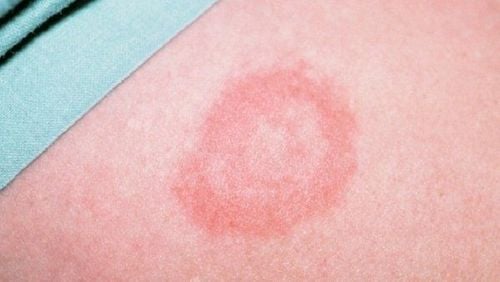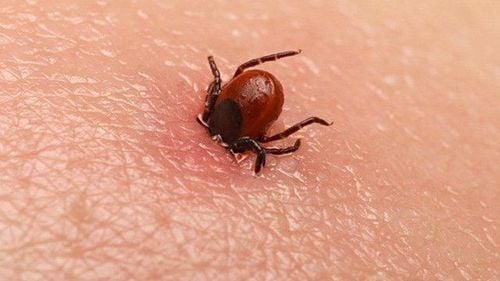This is an automatically translated article.
The article is expertly consulted by Master. Doctor Nguyen Thi Nhat - Doctor of Infectious Diseases - Department of Examination & Internal Medicine - Vinmec Hai Phong International General Hospital. The doctor has more than 10 years of experience in the field of artificial kidneys, and in the field of infectious diseases, examining and managing patients with kidney disease and infectious diseases.Lyme disease is an inflammatory disease caused by tick bites. The disease causes inflammation in many vital organs of the body, if not treated promptly, can cause severe symptoms including: Distortion of one or both sides of the mouth, joint pain, severe headache accompanied by a stiff neck, or heart palpitations.
1. What is Lyme disease?
Lyme disease is caused by a spirochete – a sinus-shaped bacterium called Borrelia burgdorferi. The disease is transmitted from animals to humans by tick bites.All ages can get lyme disease, most commonly in children, the elderly, and others such as firefighters and rangers who spend time outdoors. The disease affects mainly the skin, nervous system, heart and joints.
Lyme disease is common in Asia. The U.S. Centers for Disease Control and Prevention estimates that about 300,000 people are diagnosed with Lyme disease each year. This is 1.5 times the number of women diagnosed with breast cancer, and 6 times the number of people diagnosed with HIV/AIDS. However, diagnosing Lyme disease can be challenging because it is so difficult to identify. The peak time of illness is from June to October, but can also be sick all year round.
2. Symptoms of Lyme disease

2.1 Localized stage The patient presents with a red rash at the site of the tick bite, appearing within one month of infection. the rash becomes hot, itchy, or painful; concentric, red with a white dot in the center, or completely red.
Most patients in the focal stage often have flu-like symptoms such as headache, fatigue, muscle or joint pain.
2.2 Extensive stage The most common symptoms at this stage are cardiovascular and neurological problems. About 80% of patients have a rash.
Approximately 10% of patients who do not receive antibiotics develop neurological damage including meningitis or headache.
2.3 Late stage Symptoms of late stage develop months or even years after a tick bite. This stage causes patients to suffer from intermittent joint pain in many joints.
3. Effects of Lyme .'s Disease

3.1 Difficulty concentrating Lyme disease can cause cognitive problems that make it difficult for people to concentrate on work.
3.2 Amnesia People with Lyme disease are likely to experience short-term memory loss. They find it hard to remember what others say, where they put things, and make appointments right.
3.3 Fatigue Feeling tired, exhausted and even drowsy is one of the signs of Lyme disease. Often the fatigue caused by Lyme disease is related to the fatigue of congestive heart failure.
3.4 Sore Throat A sore throat can be a sign of Lyme disease. When you have Lyme disease, you will experience a severe sore throat.
3.5 Difficulty Hearing Hearing can also become less functional in some cases of Lyme disease, making it often difficult for the person to concentrate on a conversation.
3.6 Injury to the Feet Even though you don't walk much, but your foot suddenly hurts for no apparent reason, Lyme could be the culprit behind that pain. Patients may not notice pain throughout the day, but feel light-headed and achy in their legs when getting up from a chair or bed.
3.7 Slow heart rate Lyme disease can cause heart problems, most commonly slowing the heart rate. If the heart rate becomes too slow, the risk of death is very high.
3.8 Loss of appetite Lyme disease can affect taste, making food less appealing. Symptoms of loss of appetite are similar to those of an eating disorder.
3.9 Sensitivity to light People with Lyme disease often become sensitive to light, sometimes to the point of needing to wear sunglasses indoors or even cover their eyes while sleeping.
3.10 Panic Some Lyme patients report experiencing extreme fear. For some people, the mood is always restless, anxious and often thinks that they will die.
3.11 Limited vision People with Lyme sometimes find it difficult to focus when looking at something. If glasses don't improve vision either, think about the possibility of Lyme disease.
3.12 Menstrual disorders When Lyme disease flares up, it leads to hormonal changes that make a woman's menstrual cycle irregular.
4. Prevent Lyme Disease

Here's a list of things you can do to prevent Lyme disease:
Wear long pants and a long-sleeve shirt outdoors Keep your surroundings clean, clear nooks and crannies or places where ticks can Most living and developing organisms are trees. Use insecticides periodically. Do not keep furry animals in the house such as dogs and cats. If so, bathe them regularly and use safe insecticides to minimize the tick's habitat. Use caution even if you have ever had Lyme disease. After recovering from the disease, although the body has produced certain antibodies, many people still get sick more than once. Lyme disease is an infectious disease caused by bacteria, and the disease has dangerous symptoms that affect people's living and working activities. The disease is also capable of spreading into an outbreak and can appear dangerous complications. So, when you have any abnormal symptoms, go to a medical facility immediately to be diagnosed and treated promptly to avoid spreading the disease.
Please dial HOTLINE for more information or register for an appointment HERE. Download MyVinmec app to make appointments faster and to manage your bookings easily.














